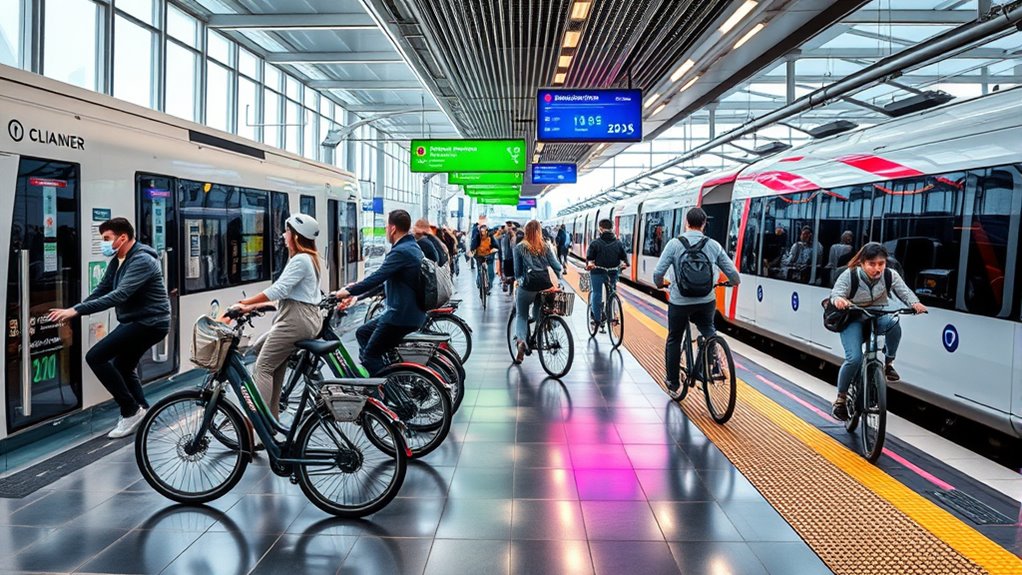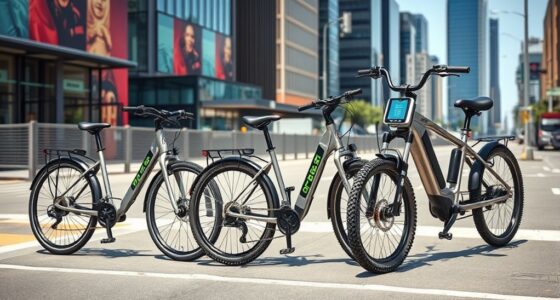Across major cities in 2025, rules for e-bikes on transit systems focus on safety, parking, and integration. You’ll find designated parking zones to prevent sidewalk blockages and guidelines that connect e-bikes with transit hubs for easy last-mile trips. Regulations also cover helmet use, rider age, and bike speed limits. Cities are expanding bike lanes and secure stations to support eco-friendly, accessible mobility. Keep exploring to discover how these rules shape your daily commute.
Key Takeaways
- Major cities are integrating e-bikes into transit networks via bike sharing programs connected to transit hubs.
- Regulations specify designated parking zones, capacity limits, and fines for improper e-bike parking.
- E-bike usage often requires helmets and age restrictions to ensure rider safety.
- Infrastructure improvements, like dedicated bike lanes and secure stations, support seamless e-bike transit integration.
- Policies promote eco-friendly mobility, reducing traffic congestion and emissions through shared e-bike systems.

Have you ever wondered how e-bikes are changing the way we use transit systems? Today, more cities are integrating e-bikes into their transportation networks, and bike sharing programs play a significant role in this shift. These programs make e-bikes accessible to a broad range of users, offering a convenient and eco-friendly alternative for short trips. As cities embrace this trend, they’re also updating parking regulations to accommodate e-bikes and ensure the smooth operation of bike sharing stations. Many urban areas now designate specific zones for e-bike parking, reducing clutter and preventing bikes from blocking sidewalks or transit entrances. This integration encourages more people to incorporate e-bikes into their daily commutes, especially when combined with existing transit options like buses and trains.
In major cities, you’ll find that bike sharing programs are often linked with transit hubs, making it easy to switch from a bus or train to an e-bike for the last mile of your journey. This convenience not only saves you time but also relieves congestion on public transit. Cities are actively working on regulations that support this synergy, such as setting clear guidelines for where e-bikes can be parked and how many can be stationed in certain areas. These rules help prevent overcrowding at stations and ensure that e-bikes are available for everyone. Additionally, some cities have implemented fine systems for improperly parked bikes, encouraging responsible riding and parking habits. By streamlining parking regulations and expanding bike sharing services, cities aim to make e-bikes a seamless part of daily mobility.
The combination of bike sharing programs and parking regulations shows a city’s commitment to sustainable transportation. When you use an e-bike from a sharing station, you’re participating in a system designed to reduce traffic, cut emissions, and promote healthier lifestyles. As more cities adopt these policies, you’ll notice designated bike lanes and secure parking areas popping up around transit stations, making it easier and safer for you to ride. The evolving rules also address safety concerns, requiring riders to follow age restrictions or helmet laws, further integrating e-bikes into the broader transit ecosystem. A focus on high-quality projectors and proper infrastructure can further enhance the overall experience for users. Overall, the emphasis on well-regulated bike sharing programs and parking solutions demonstrates a forward-thinking approach to urban mobility, making your daily commute more flexible, affordable, and environmentally friendly.
Frequently Asked Questions
Can I Bring My E-Bike on Transit During Peak Hours?
You can usually bring your e-bike on transit during peak hours, but rules vary by city. Be sure to use designated e-bike parking areas and follow local guidelines. To prevent theft, always lock your e-bike securely and avoid leaving it unattended for long periods. Check your transit system’s specific policies beforehand, as some cities may have restrictions or require advance arrangements during busy times.
Are There Size or Weight Restrictions for E-Bikes on Transit?
Yes, there are size and weight restrictions for e-bikes on transit. Most transit systems follow bike rack regulations, typically accommodating bikes up to a certain length and weight limit. Foldable e-bikes are often easier to carry onboard because they fit more easily into designated spaces. Always check your city’s specific rules before traveling, but generally, keeping your e-bike within size and weight limits ensures smooth transit with minimal hassle.
Do E-Bike Rules Vary Between Urban and Suburban Transit Systems?
Sure, urban regulations often treat e-bikes like royalty, with strict rules about where you can ride. Suburban policies, on the other hand, tend to be more laid-back, like a Sunday afternoon. So, yes, your e-bike adventures will face different rules depending on whether you’re in bustling city streets or quiet suburban neighborhoods. Keep an eye on local policies, or you might find yourself unexpectedly banned from certain transit systems!
Is There a Fee to Bring an E-Bike on Transit?
Yes, there’s often a fee to bring your e-bike on transit, depending on the city and transit system. You’ll need to check if your e-bike requires specific E bike insurance or meets maintenance requirements set by the transit authority. Some systems charge extra for bike storage, while others include it in your regular fare. Always verify the rules beforehand to avoid surprises and guarantee smooth travel with your e-bike.
How Are E-Bike Batteries Stored or Charged During Transit?
You’ll want to keep your e-bike batteries stored in a safe, well-ventilated area during transit, avoiding extreme temperatures. Charging protocols emphasize disconnecting batteries and ensuring they’re not damaged or swollen, prioritizing battery safety. While on transit, batteries are typically kept in carry-on luggage or designated storage compartments, never in checked baggage. This careful handling prevents fire risks and guarantees safe transportation, giving you peace of mind and peace on your journey.
Conclusion
So, as you navigate these evolving rules, you might think e-bikes are a hassle—until you realize they’re actually making transit more flexible. Ironically, cities are cracking down just as e-bikes make your commute smoother and faster. Maybe, in the end, it’s not the bikes that need regulation, but our stubborn ideas about how we should get around. Keep riding smart—who knows, one day, e-bikes might just be your favorite part of the journey.









